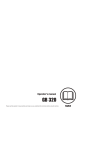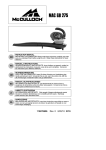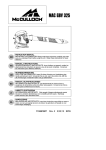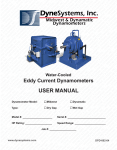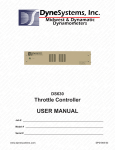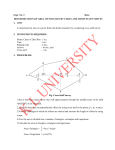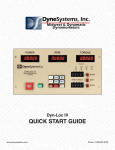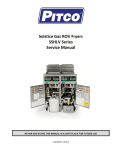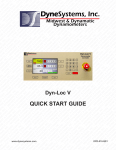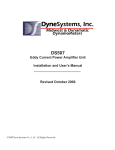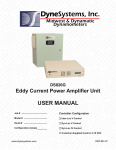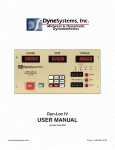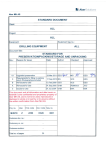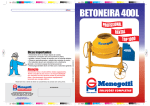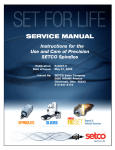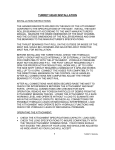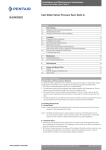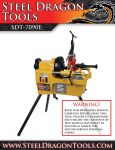Download Dynamometer Maintenance Guide
Transcript
R ~ N M M M N E M N E M S AT N T E ~ M S M N T E . D S , D E S M A I A Y E O , & R ~ Y M Y ST D S A A ~ DW AM S, TI E S T & ETE INC IC E S & D RS ID NA EM YN ~ MID M S, I TIC NE ST M INC TI E S D S M NA YS YN RS AT DY ES OM IN C D YS D R . DY YS Y ~ D W MO S AM DY W OM NC D SY & ET . C D YS YN ~ D ID M TE AM ~ W O M , E D E ~ N C N E E . Y T A T Y S ~ N I N C C D E T & ETE . ~ YN EM NA ~ D MI AM TEM AM YN ST ME INC AT E ST TE ~ M NA ST YN RS MI YN EM MA YN ES ME S, AT .~ Y S D R M A S, M YN DW OM S AT E S & D TE . ~ IC SY & RS ID M EM AM ~ DW AM S, TI E S T & TE INC M Y Y N I S A D S D C , R S M O D ~ ID AM TE NA ~ DW OM INC TIC E ES ET IN IC D YS YN S MI YN TE YN ~ WE M S, I AT YN ES OM INC D YS D RS . S T D S E N IC T E . Y T Y D W O M M D E E T E C A ~ D A M M YN ES M S, AT YN ST TE . ~ DY YS & D RS . ~ YN EM M DY WE M S, AM YN T TE C. D E S & D TE ~ M NA EM NA ~ AT E T E I IC E & R M N TE Y M AM S AT N S O IN AT E & R ~ YN Y M S M Y R , I IC SY & TER NC D SY D S ~ IDW AM M NA ~ D IDW O , IN IC E S T & ME C IC SY DY S ~ MID AM ST NA S ~ IDW OM , IN ATI N D S D S . ~ YN S YN D E O S, M Y M C D Y D TE . ~ D S N D W O EM M D E E C E C Y T Y N ET . ~ YN S Y R M Y TE AM Y T M I Y S A A S ES M S, AT YN ST TE . ~ N N TE . ~ NA EM NA ~ D MI AM EM M N T E NC T E T N T S M I E A E R MI M S, M YN DW OM S AT E S & D TE . ~ IC SY & RS MID AM EM AM ~ DW AM S, TI E S T & TE INC IC E S & D RS S D Y A D C S , R D O D S A D O ~ I Y E O I E Y W N AM ~ D W ME INC TIC E S ST ET INC C D ST YN S ~ MID YN TE YN ~ D E ME , IN TI YN ST ME NC DY ST DY RS . ~ YN ST YN E C A M A S E A A M S, AT YN ST TE . ~ DY YS & D RS . ~ YN EM M DY WE M S, AM YN T TE C. D E S & D TE . ~ NA EM NA ~ D ID M EM M M A S AT N S O I AT E & R ~ Y Y I IC E & R M N TE Y Y R M M S M Y W O S ER NC D SY D S ~ IDW AM M NA ~ D IDW MO , IN IC E S T & ME NC IC SY DY S ~ MID NA ST NA S ~ IDW OM , IN ATI NE ES ME , IN S . ~ YN ST YN DY E OM S, I M YN E ME C. DY YS D TE . ~ DY ST NA DY W MO EM M DY ES ET C. C D SY T & TE N ~ MI AM E AM N ST E NC AT E ST TE ~ N T YN RS MI N EM M N ES M S, AT N T E ~ M Y ST D R AM D D M A E A R YN W OM S AT E S & D TE . ~ IC SY & RS MID M EM AM ~ DW AM S, TI E S T & TE INC IC D E S & D S ID NA EM YN A D C S , R D O D S O IN TI E ES E IN IC YS Y S M Y T Y ~ W M , AT Y ES M IN D YS D R . ~ Y YS Y ~ D W MO S A E N T N C Y T Y S C C S T T C D T N ~ ID N E N D E E IN I N T M , TE . ~ D YS & ER . ~ YN EM AM D W AM MS AM YN ST TE C. C D E S & ETE . ~ NA EM NA ~ D MID AM EM AM YN ST E INC R M YN TE DY S ~ M AM S AT YN ES OM , IN AT E & RS ~ YN Y DY RS MI M S, MA YN W OM S AT E S & D TE S ID A , R S , M ID D O I I E T E Y I S D N AT ~ D W MO MS NAM DY W OM INC C D SY & ET C. C D YS YN ~ D ID AM TE AM ~ D W ME INC TIC E S ST ET INC C D ST YN S IC Y ES M , IN A NE ES ET . ~ YN S DY ER ~ M Y TE AM Y WE OM MS A Y ES T . ~ D YS & ER . ~ YN EM AM C D NE T ET C TI S T E M A TE NA S ID NA M A NE S E , I TI NE T & ER M YN T D S M A S .~ Y & E . ~ C Y & R ID M M M ~ W M S T T T N C E Y M S S I S , N & ER C D SY D S ~ IDW AM MS NA ~ D IDW O , IN D D C S R D O D S O Y S M A Y Y S M Y T Y ~ W M , A Y E I Y . N Y ~ ID M ST N ~ ID N E N D E E IN TIC N ST ME C DY ST DY S ~ N ST N DY ES OM , I M YN E ME AT DY WE OM EM AM DY WE AM MS AM YN ST TE C. D E S & TE . ~ NA EM NA ~ D MID AM EM AM NE T ET NC ATI E S ST TE IC NE ST ET S, AT N S OM , IN AT E & D RS ~ M YN YS DY RS MI M S, MA YN W OM S, AT S & D ER . ~ C D YS & D C DY SY & ER IN IC E S T & E C. IC SY Y ~ ID AM TE NA ~ DW OM IN TI E ES ET IN IC YS YN S MI YN TE Y . ~ N S D S C D Y D TE ~ D S N D W O M M D E E C C S T M E C D T A ~ D AM TE YN ~ . ~ YN ST YN RS M YN TE AM YN ES M S, AT YN ST TE . ~ DY YS & RS . ~ YN EM M DY WE AM S, M M ~ ID I A O T D M A D W OM MS AM DY MID AM EM AM ~ DW AM S, ATI E S T & ETE INC IC E S & D RS ID NA EM YN ~ MID M S, I TIC NE ST M M YN E E , I AT NE W OM S, A DY E OM IN C YS D R . DY Y Y ~ W MO S A DY W OM NC D S & E AT E S T N IC S E E IN TI N ST E C DY T Y S ~ N ST N D E YN S M , IN MA NE ES ET . ~ YN YST DY T E C C A M S A . ~ E E N S Y E I T C N T .~ C Y & R .~ D S T E . D S & E ~ A M A D ID M M M E T ET C TI S T E M A E N M DY ST DY S ~ M YN TE & D RS ~ M YN YS DY RS MID MO S, MA YN W OM S, ATI S & D ER . ~ C D YS & D RS ID MO MS ~ IDW NA EM NA DY IDW AM MS YN ~ ID AM TE NA ~ W M INC TIC E ES ET IN C D YS YN S MI YN TE YN ~ WE M , C S T D E D ~ D T D YN ES MO S, MA NE ES OM , IN AM YN WE OM MS MA DY ES ETE . ~ D YS & ER . ~ YN EM AM D W AM MS AM YN ST TE TI E T M IN TI S T E C A E S E , TI NE T R M YN TE DY S ~ M AM S AT YN ES OM , IN AT E & IN C & T C C . T T C T E S I , Y & & S C D SY D TE . ~ D ST D ER ~ M IC Y & ER C. DY SY DY ~ DW AM MS NA D IDW O IN IC E S T & ET C. IC SY DY M . ~ YN S Y R M Y Y D EM YN S ID DY ST Y S ~ N ST NA DY ES OM , I MA N E E C. DY YS DY E ~ DY ST N T N S I R MID AM EM AM ~ DW AM S AM ~ D WE NA EM NA ~ D MID AM EM M NE T ET NC TI E S ST TE ~ M NA TE NA RS MID NA EM S W O S A D E O , IN A YN S M S M Y W O S AT S & E . ~ C Y & RS ID M M M ~ W M N ~ D ES ME , IN TIC YN ST ME C. TIC E T & OM , IN ATI NE ES ME , IN IC YS DY RS M DY ST DY ~ W OM S, AT DY ES O AM Y T T C I N I E E N E ER . ~ DY S & D TE ~ M DY SY DY ET C. ~ C D SY T & TER C. DY TE AM ~ D DW AM MS NA DY ST ET NC IC NE T & N & IN AT E S D S M N YS Y RS ID N ST N ER M YN ST D S ~ M NA MS A Y E O , MA NE & ER . ~ DY SY C IC Y Y ~ ID AM T NA ~ W AM EM AM S ID A E Y ~ ID M , TI NE ST M IN TI S D S M N S . M N E ER ~ M DY ST NA DY W O M MA DY ES O S, AT ~ D W MO S AM DY W OM INC C D SY & ET C. ~ C D YS YN ~ D IDW AM T M , E S D E E E M M E S ID NA M A NE S E , TI NE T E IN IC Y S M IN A NE S ET . ~ YN S Y R M YN TE AM YN E OM S R Eddy Current Dynamometers Water-Cooled MAINTENANCE GUIDE (Excerpt from User’s Manual) www.dynesystems.com SECTION 7: MAINTENANCE Service life of a dynamometer and the quality of test results depend on routine maintenance received during its lifetime. Inadequate maintenance increases the probability of sudden and catastrophic failures. Routine maintenance is the best assurance of trouble free operation. The purpose of this Maintenance Section is to guide users in setting up a good maintenance program. Although many factors affect the service life of any machine, this manual cannot cover all contingencies, but it can assist experienced maintenance personnel in maintaining the dynamometer in foreseen conditions. Refer any questions to DS Service Department. CHECK LIST A checklist should be prepared which includes all maintenance check points pertaining to the equipment. The following is a list of suggested items to be included on such a checklist: 1. Nameplate information 2. List of drawings 3. Speed Ranges 4. Load Ranges 5. Coil Ratings including voltage, current, and cold resistance. 6. Water Service including normal drain temperature, GPM required, and pressure. 7. Lubrication Service, including type of grease, type of oil, viscosity. 8. Air Service including type and pressure. 9. Safety Settings including low coolant pressure, high coolant temperature, low oil pressure. 10. Alignment Data, including angular and parallel maximum limits. 11. Vibration including normal readings. 12. Service Record including date or maintenance cycle when above test points should be checked. 13. Repair Record including date and description of problems versus items repaired or replaced. INSPECTION During routine maintenance, visually check for loose bolts, missing shaft guards, coolant or lubricant leaks, and excessive dirt on cooling surfaces. Question the operator to determine if abnormal conditions exist or a change in operation has been noted. Compare operation of unit with its performance profile. Investigate any changes noted on check list. Carefully check air filters, strainers, and auxiliary support devices. Dyne Systems • WATER-COOLED EDDY CURRENT DYNAMOMETERS DPD-002-01 • © Copyright Dyne Systems, Inc. 7 - Maintenance 41 CLEANING If filters or screens are plugged or dirty, remove and clean them. When they cannot be properly cleaned, replace them. Clean equipment of excessive dirt, oil, and other contamination that may work into the unit and cause a problem. LUBRICATION Absorption dynamometers include two types of bearings (trunnion and rotor). Trunnion bearings are grease lubricated. Rotor bearings are lubricated with either constant level oilers, a pressurized re-circulating oil system or grease. Do NOT mix brands or types of lubricant unless manufacturer guarantees compatibility. Excessive lubricant will cause bearings to overheat. Tunnion Bearing Grease Unless specified otherwise, trunnion bearing grease is general purpose industrial NLGI No. 2 grade mineral oil with a lithium base. Recommended trunnion bearing greases are listed in Table 7.1: Manufacturer Brand Name Shell Alvania No. 2 Texaco Multifax No. 2 Texaco Regal AFB2 Mobil Mobilux No. 2 Table 7.1 Recommended Oil Specifications for Rotor Bearings Oil lubricated rotor bearings require a high grade mineral oil free from water, sediment, acid, resin, and other substances not derived from petroleum products and resistant to rust and oxidation. Recommended oil specifications are listed in Table 7.2 according to operating temperature and rotating speed of bearings. Also refer to drawings and contract specifications. Ambient Temperature Range Viscosity of Oil at 38°C (100°F) in Saybol Universal Seconds (S.U.S.) Under 2000 RPM 2000 to 6000 RPM Over 6000 RPM -18° to 4°C (0° to 40°F) 160 – 200 120 – 160 92 – 100 4° to 38°C (40° to 100°F) 200 – 320 160 – 200 120 – 160 38° to 66°C (100° to 150°F) 320 – 540 200 – 320 160 – 200 Table 7.2 Oils Provided by Dyne Systems Oil types provided by Dyne Systems are based upon the oil system supplied with the dynamometer. These are listed below in Table 7.3. Oil System Oil Type Constant Level Oiler Exxon Nuto H 68 Oil Circulating System Mobil Nuto H 32 Oil Mist Lubrication System Mobil Mist Lube 27 Table 7.3 42 Dyne Systems • WATER-COOLED EDDY CURRENT DYNAMOMETERS DPD-002-01 • © Copyright Dyne Systems, Inc. 7 - Maintenance MAINTENANCE SCHEDULE GUIDELINES The following are only guidelines, if the dynamometer is used extensively or in a harsh environment, the maintenance schedule will need to be adjusted accordingly. DAILY Check Oil Level Please choose the instructions below that pertain to your type of system: Constant Level Oiler 1. It should be between ½ and ¾ full. Do NOT over fill. 2. Turn the reservoir bottle counter-clockwise. 3. Lift the bottle from oiler. 4. Fill bottle using Exxon Nuto H 68 librication oil or similar oil. 5. Quickly install bottle on oiler. Oil will flow from the bottle until the bearing chamber and tube of the oil have been filled with oil. 6. Fill the bottle as many times as necessary until the oil level in the bottle remains constant. The oil level must be visible in the transparent bottle of the oil reservoir at all times while the dynamometer is in operation. Do NOT allow the reservoir to run dry. The position of the oilers with respect to the bearing centers has been established at the factory for proper operation of the constant level oiling system. This position must never be altered. Pressurized Re-Circulating Oil System 1. It should be between ½ and ¾ full. Do NOT over fill. 2. Remove oil reservoir cap. 3. Fill to appropriate level, using Exxon Nuto H 32 lubrication oil or other similar oil. 4. Replace oil reservoir cap. 1. Check coolant hoses for cracks. Replace as required. 2. Check for coolant leaks. Repair as required. 3. Check for oil leaks. Repair as required. MONTHLY Dyne Systems • WATER-COOLED EDDY CURRENT DYNAMOMETERS DPD-002-01 • © Copyright Dyne Systems, Inc. 7 - Maintenance 43 EVERY 3 MONTHS 1. Check Carcass Movement 1. Loosen or remove the anti-rotation safety stop and disconnect the Load Measuring System from carcass. 2. Gently move the torque arm up and down to verify that the carcass moves freely in the trunnion bearings. 3. If the carcass does NOT move freely, check for interference (such as wires, hoses, brinelling of the trunnion bearings, dry or hard trunnion bearing grease, etc). 4. Reconnect the Load Measuring System to the carcass and tighten or reinstall the anti-rotation safety stop. 2. Rotate Trunnion Bearing Rotators / Shift Rings (if applicable) 1. Disconnect the Load Measuring System from the Carcass. 2. Depending upon type of dynamometer, loosen the screws of either the pedestal caps or enclosure top. 3. Rotate each (2) rotator about 15° by hand using a rod that fits into the machined holes of the rotators. 4. Gently move the carcass by hand. It should move freely without binding or restriction. If the carcass does NOT move freely, check for interference (such as wires, hoses, brinelling of trunnion bearings, dry or hard trunnion bearing grease, etc.). 5. Securely tighten the screws on either the pedestal caps or enclosure top. 1. Check TIR of the shaft. It should not exceed 0.001”. 2. Make sure the coolant pressure gauge is functioning properly. 3. Make sure the exit coolant temperature switch is functioning properly. Remove temperature sensor and check with calibrated thermometer using water. 4. Check the Y-Strainer filter (if applicable) and clean if needed. 5. For pressurized re-circulating oil system, check filters and screens and replace them if they cannot be cleaned. 1. Make sure the solenoid valve is functioning properly. 2. For pressurized re-circulating oil systems, drain, clean and change oil. 3. Check the trunnion bearings to make sure grease is not dry or hardened. If required, repack with fresh grease or replace bearings. 4. Check vibration using an Accelerometer. EVERY 6 MONTHS: ANNUAL • 3600 RPM and less should not exceed 0.20 V in/sec. • 3601 RPM and greater should not exceed 0.15 V in/sec. 44 Dyne Systems • WATER-COOLED EDDY CURRENT DYNAMOMETERS DPD-002-01 • © Copyright Dyne Systems, Inc. 7 - Maintenance STORAGE 12 Months or Less 1. Store in clean, dry area within the following temperature limitations: 10°C (50°F) to 50°C (120°F). Humidity should not exceed 60%. Open all airtight coverings to permit air circulation. Vibrations from heavy moving vehicles can be transmitted through the floor. Avoid storage in heavy traffic areas as bearing damage may result. 2. On a monthly basis, rotate shaft by hand to lubricate bearings and alternate shaft position to prevent brinelling. 1. Store in clean, dry area within the following temperature limitations: 10°C (50°F) to 50°C (120°F). Humidity should not exceed 60%. Open all airtight coverings to permit air circulation. Vibrations from heavy moving vehicles can be transmitted through the floor. Avoid storage in heavy traffic areas as bearing damage may result. 2. Prepare an anti-rust water mixture of 50 parts water to one part DuPont No 7 Rust Inhibitor to prevent rusting inside dynamometer carcass, cooling passages and sump. Pump mixture into normal coolant inlets and allow drainage in normal manner. Operate Wet Gap dynamometers at minimum of 1750 rpm. Dry Gap dynamometers do not require rotation. Drain anti-rust water mixture. 3. To prevent damage from coolant freezing, open drain cocks or pipe plugs provided. Tag dynamometer to indicate drains are open. 4. For protection of oil lubricated bearings, prepare an anti-rust oil mixture. Select a high grade mineral oil resistant to rust and oxidation with a viscosity of 200 to 320 S.U.S. at 38°C (100°F). Mix four parts oil to one part Quaker Ferrocote No. 5684. 5. If constant level oilers are used, drain oil from the system, refill with anti-rust oil mixture. Elevate oiler to ensure oil flow into bearing cavities. Relocate oiler in proper position and turn shaft by hand to coat bearings. Greater Than 12 Months On a monthly basis, rotate shaft by hand to lubricate bearings and alternate shaft position to prevent brinelling. 6. If a pressurized re-circulating oil system is used, drain oil from system, refill with anti-rust oil mixture (described above). Connect circulating pump to proper electrical service and run pump for minimum of two hours. On a monthly basis, rotate the shaft by hand to lubricate bearings and alternate shaft position to prevent brinelling. 7. Greased lubricated trunnion and rotor bearings should be hand rotated and repositioned monthly to redistribute bearing grease and to prevent brinelling. When placing dynamometer back into service, drain anti-rust oil mixture from oil piping system and replace with recommended oils (See Tables 7.2 and 7.3). Inspect grease lubricated trunnion and rotor bearings and repack with recommended grease (refer to Table 7.1). If using a closed-loop cooling system, flush the dynamometer prior to putting it back into operation. Dyne Systems • WATER-COOLED EDDY CURRENT DYNAMOMETERS DPD-002-01 • © Copyright Dyne Systems, Inc. 7 - Maintenance 45 SECTION 8: TROUBLESHOOTING The possibility of a component failure or other problems always exists. This section of the manual is intended to provide assistance in finding the fault. Check the obvious first then follow the Trouble Shooting Guide. PROBLEM Dynamometer will not Load POSSIBLE FAULT 1. Controller malfunction; no coil excitation 2. Loose or incorrect wiring 3. Defective field coil 4. Water pressure, oil pressure or temperature switch open Noise 1. Vibration from imbalance or misalignment 2. Bearing failure 3. Improper mounting 4. Shaft coupling loose Hot Unit 1. Overloaded 2. Lack of coolant 3. Defective modulating valve 4. Plugged cooling passages Hot Bearings 1. Bearing damage 2. High thrust load 3. Lack of, or wrong lubricant 4. Misalignment 5. Bent shaft Dynamometer Stops Operation 1. Controller malfunction 2. Overload (causing collapsed rings and locked rotor) 3. Safety interlock operating 4. Cooling or lubricant failure Erratic Operation 1. Controller malfunction 2. Trunnion bearing binding 3. Load measuring system malfunction 4. Surging coolant 5. Defective bearing 6. Speed feedback malfunction 7. Torque feedback malfunction 8. Electrical noise 9. Loose electrical connection Hysteresis 1. Dynamometer not statically balanced. 2. Hoses binding the dynamometer carcass. 3. Trunnion bearings dirty or worn. 4. Load cell linkage is loose. Table 8.1 - Troubleshooting Guide 46 Dyne Systems • WATER-COOLED EDDY CURRENT DYNAMOMETERS DPD-002-01 • © Copyright Dyne Systems, Inc. 8 - Troubleshooting







